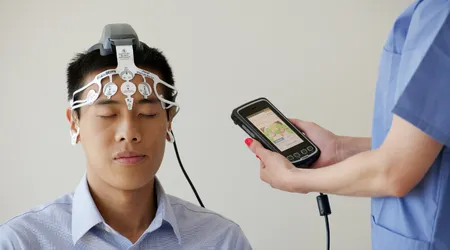The Rise of Wearables for Neurological Disabilities

Wearables for neurological disabilities are reshaping how individuals with conditions like Parkinson’s, epilepsy, or stroke navigate daily life.
These cutting-edge devices, blending artificial intelligence (AI), sensors, and user-centered design, empower users by enhancing mobility, communication, and independence.
In 2025, the assistive technology landscape thrives on innovation, driven by a global push for inclusivity.
With the World Health Organization projecting 3.5 billion people needing assistive tech by 2050, wearables stand out as transformative tools.
This article dives into how these devices are redefining accessibility, their technological advancements, real-world impact, and the challenges ahead.
Why settle for limitations when technology can unlock potential?
The Evolution of Wearables: From Fitness Trackers to Life-Changing Tools
Once simple step-counters, wearables now tackle complex neurological challenges.
Wearables for neurological disabilities use AI and sensors to monitor tremors or seizures, offering real-time data.
Devices like the Naqi Neural Earbuds, honored at CES 2025, allow hands-free device control for quadriplegics.
This shift reflects a broader trend: technology prioritizing inclusivity. Smart gloves, like Neofect’s, aid stroke survivors in regaining hand function through gamified rehab.
++ Top 10 Assistive Apps Changing Lives in 2025
These advancements show wearables evolving beyond fitness into vital assistive tools.
Consider Maria, a fictional Parkinson’s patient using a tremor-stabilizing wristband. It adjusts to her movements, letting her write again.
Such innovations highlight wearables’ role in restoring agency and dignity.

How Wearables Work: The Tech Behind the Transformation
Sophisticated yet intuitive, wearables for neurological disabilities integrate sensors, AI, and IoT for personalized support.
For example, EMG sensors in smart gloves track muscle activity, guiding rehab. AI algorithms adapt to user progress, ensuring tailored interventions.
The mobile ankle-foot exoneuromusculoskeleton (ENMS) corrects post-stroke footdrop using vibrotactile feedback and neuromuscular stimulation.
Also read: Smart Glasses for the Deaf: What’s New in 2025
This lightweight system supports self-managed rehab, reducing clinical visits. Connectivity with smart home systems further enhances usability.
Imagine a conductor orchestrating a symphony wearables harmonize data, user needs, and real-time feedback.
This synergy makes them indispensable for neurological support, blending precision with practicality.
Real-World Impact: Empowering Lives with Wearables
The impact of wearables for neurological disabilities is profound. A 2024 study found that HAL robotic wearables improved walking in SMA patients by 30%.
Devices like the MouthPad^ enable hands-free device control for those with motor impairments.
Take John, an imagined epilepsy patient. His seizure-detecting smartwatch alerts caregivers instantly, reducing risks.
These tools foster independence, letting users engage in work, hobbies, or social life confidently.
Beyond individuals, wearables ease caregiver burdens. Real-time data sharing with doctors optimizes treatment plans, bridging gaps in healthcare access, especially in underserved areas.
Challenges and Barriers: Accessibility and Adoption
Despite their promise, wearables for neurological disabilities face hurdles. High costs often thousands of dollars limit access, particularly in developing nations.
Awareness remains low, with many unaware of these technologies.
Usability is another issue. Complex interfaces can overwhelm users with cognitive impairments.
Cultural stigmas around visible devices also deter adoption, as some fear judgment. Manufacturers must prioritize intuitive, discreet designs.
Economic barriers compound these challenges. Without insurance coverage or subsidies, many cannot afford wearables.
Advocacy for policy changes, like tax reductions on assistive tech, is critical to democratizing access.
The Role of AI and IoT: Smarter, More Connected Devices
AI and IoT are the backbone of modern wearables for neurological disabilities.
AI-driven devices, like H-Medi’s gait-correcting robot, predict disease progression with 92% accuracy. IoT enables seamless integration with smart homes, enhancing user control.
For instance, voice-activated wearables allow users with motor disabilities to manage lighting or appliances effortlessly.
This connectivity fosters independence, reducing reliance on caregivers. Data sharing with healthcare providers also improves outcomes.
However, privacy concerns linger. AI relies on personal data, raising risks of breaches.
Ethical design using encryption and transparent data policies ensures user trust, balancing innovation with security.
Inclusive Design: Putting Users at the Heart of Innovation
Great design listens. Wearables for neurological disabilities thrive when co-created with users.
Seekr, a compact AI wearable for the visually impaired, emerged from community collaboration, prioritizing sleek, non-medical aesthetics.
User-centered design ensures devices are intuitive and culturally sensitive.
For example, customizable interfaces accommodate cognitive disabilities, while discreet form factors reduce stigma. Feedback loops with users drive continuous improvement.
Involving diverse communities across age, gender, and socioeconomic backgrounds prevents biased designs.
Inclusive innovation isn’t just ethical; it’s smart, expanding market reach and ensuring devices meet real needs.
The Future of Wearables: What Lies Ahead in 2025 and Beyond

The horizon for wearables for neurological disabilities is bright. By 2030, the wearable tech market is projected to grow at a 14.6% CAGR, fueled by accessibility demands.
Brain-computer interfaces (BCIs) like Cognixion’s Axon-R promise non-invasive neural control.
Augmented reality (AR) wearables could enhance cognitive rehab for dementia patients, while 3D-printed custom devices lower costs.
Partnerships, like the NHS’s with AposHealth, signal scalable adoption.
Yet, ethical questions loom. Will innovation prioritize profit over equity?
Collaborative efforts between governments, tech firms, and communities must ensure wearables remain accessible, affordable, and transformative.
Table: Key Wearable Devices for Neurological Disabilities in 2025
| Device | Function | Target Condition | Key Feature |
|---|---|---|---|
| Naqi Neural Earbuds | Hands-free device control | Quadriplegia, ALS | Non-invasive BCI |
| Neofect Smart Glove | Hand rehab | Stroke, SCI | Gamified exercises |
| H-Medi Wearable Robot | Gait correction | Stroke, Parkinson’s | 92% accurate AI |
| MouthPad | Hands-free device control | Motor impairments | Tongue/head gestures |
Policy and Advocacy: Driving Systemic Change
Policy shapes access. Governments must fund assistive tech, as the UK does through UKRI’s £15 million for prosthetics research.
Subsidies and tax breaks can lower costs for wearables for neurological disabilities.
Advocacy groups like the Global Disability Innovation Hub push for inclusive policies.
Public-private partnerships can scale production, making devices affordable globally. Awareness campaigns also combat stigma, encouraging adoption.
Grassroots efforts matter too. Community-led workshops can educate users about wearables, demystifying technology.
Systemic change starts with collective action, ensuring no one is left behind.
A Call to Action: Embracing the Wearable Revolution
Wearables for neurological disabilities are more than gadgets they’re lifelines.
From restoring mobility to fostering independence, they redefine what’s possible. In 2025, the assistive tech revolution is here, but its success hinges on accessibility, awareness, and ethics.
Stakeholders tech innovators, policymakers, and communities must collaborate. Invest in inclusive design, advocate for subsidies, and amplify user voices.
The future isn’t just wearable; it’s equitable, empowering, and human-centered.
Let’s ask: What kind of world do we want one where technology liberates or excludes? The answer lies in our commitment to inclusivity. Join the revolution support wearables that transform lives.
Frequently Asked Questions (FAQs)
Q: What are wearables for neurological disabilities?
A: They’re devices like smart gloves or earbuds that use AI and sensors to assist with mobility, communication, or rehab for conditions like Parkinson’s or stroke.
Q: Are these wearables affordable?
A: Costs vary, often high without insurance. Advocacy for subsidies and tax breaks aims to improve affordability, especially in developing regions.
Q: How do wearables ensure user privacy?
A: Ethical designs use encryption and transparent data policies to protect personal information, though users should verify manufacturer practices.
Q: Can wearables replace traditional rehab?
A: They complement rehab, offering self-managed exercises and real-time data, but medical supervision remains crucial for tailored treatment plans.
Q: Where can I learn more about these devices?
A: Check CES 2025 award lists, WHO’s assistive tech reports, or consult healthcare providers for device recommendations tailored to specific needs.
